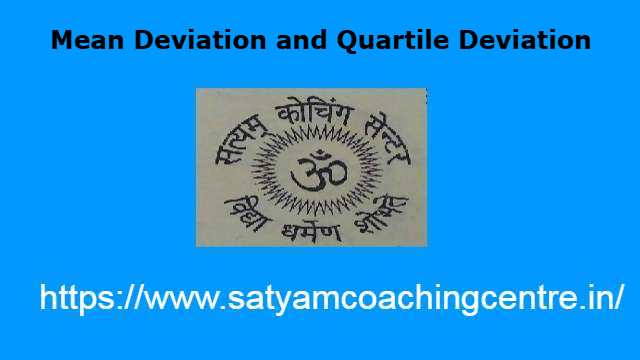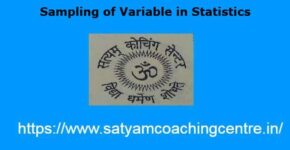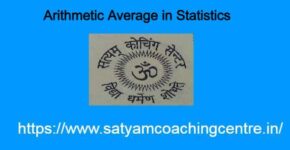Mean Deviation and Quartile Deviation
1.माध्य विचलन और चतुर्थक विचलन (Mean Deviation and Quartile Deviation),माध्य विचलन (Mean Deviation):
माध्य विचलन और चतुर्थक विचलन (Mean Deviation and Quartile Deviation) के इस आर्टिकल में चतुर्थक विचलन और माध्य विचलन तथा उनके गुणांकों के सवालों को हल करके समझने का प्रयास करेंगे।
आपको यह जानकारी रोचक व ज्ञानवर्धक लगे तो अपने मित्रों के साथ इस गणित के आर्टिकल को शेयर करें।यदि आप इस वेबसाइट पर पहली बार आए हैं तो वेबसाइट को फॉलो करें और ईमेल सब्सक्रिप्शन को भी फॉलो करें।जिससे नए आर्टिकल का नोटिफिकेशन आपको मिल सके।यदि आर्टिकल पसन्द आए तो अपने मित्रों के साथ शेयर और लाईक करें जिससे वे भी लाभ उठाए।आपकी कोई समस्या हो या कोई सुझाव देना चाहते हैं तो कमेंट करके बताएं।इस आर्टिकल को पूरा पढ़ें।
Also Read This Article:- Quartile Deviation and Its Coefficient
2.माध्य विचलन और चतुर्थक विचलन के साधित उदाहरण (Mean Deviation and Quartile Deviation Solved Illustrations):
Illustration:1.चतुर्थक विचलन का प्रयोग करके बताइए कि निम्न दो चर-मूल्यों-A और B में किसमें विचरण अधिक है।
(Using quartile deviation,state which of the two variables -A and B is more variables):
\begin{array}{|cc|cc|} \hline \text{A} & & \text{B} &\\ \text{Mid point} & \text{frequency} & \text{Mid point} & \text{frequency} \\ \hline 15 & 15 & 100 & 340 \\ 20 & 33 & 150 & 492 \\ 25 & 56 & 200 & 890 \\ 30 & 103 & 250 & 1420 \\ 35 & 40 & 300 & 620 \\ 40 & 32 & 350 & 366 \\ 45 & 10 & 400 & 187 \\ & & 450 & 140 \\ \hline \end{array}
Solution:Calculation Table of Quartile Deviation
\begin{array}{|lll|lll|} \hline \text{A} & & & \text{B} & &\\ \text{Class} & \text{frequency} & \text{cf} & \text{Class} & \text{frequency} & \text{cf} \\ \hline 12.5-17.5 & 15 & 15 & 75-125 & 340 & 340 \\ 17.5-22.5 & 33 & 48 & 125-175 & 492 & 832 \\ 22.5-27.5 & 56 & 104 & 175-225 & 890 & 1722 \\ 27.5-32.5 & 103 & 207 & 225-275 & 1420 & 3142 \\ 32.5-37.5 & 40 & 247 & 275-325 & 620 & 3762 \\ 37.5-42.5 & 32 & 279 & 325-375 & 360 & 4122 \\ 42.5-47.5 & 10 & 289 & 375-425 & 187 & 4309 \\ & & & 425-475 & 140 & 4449 \\ \hline \text { Total } & 289 & & & 4449 \\ \hline \end{array}
variable A:
q_1=\frac{N}{4}=\frac{289}{4}=72.25
यह मद 22.5-27.5 वर्गान्तर में है,अतः l_1=22.5, i=27.5-22.5=5,c=48,f=56
Q_1=l_1+\frac{i}{f}\left(q_1-c\right) \\ =22.5+\frac{5}{56}(72.25-48) \\=22.5+\frac{5}{56} \times 24.25 \\ =22.5+\frac{121.25}{56} \\ \approx 22.5+2.165 \\ \Rightarrow Q_1 \approx 24.665 \\ q_3=\frac{3N}{4}=\frac{3 \times 289}{4}=216.75
यह मद 32.5-37.5 वर्गान्तर में है,अतः l_1=32.5, i=37.5-32.5=5,c=207,f=40
Q_3=l_1+\frac{i}{f}\left(q_3-c\right) \\ =32.5+\frac{5}{40}(216.75-207) \\ =32.5+\frac{1}{8} \times 9.75 \\=32.5+1.21875 \\ \Rightarrow Q_3 \approx 33.719
C of Q.D. A=\frac{Q_3-Q_1}{Q_3+Q_1} \\ =\frac{33.719-24.665}{33.719+24.665} \\ =\frac{9.054}{58.384} \approx 0.155 \\ \Rightarrow \text { C of Q.D. of A } \approx 0.155
variable B:
q_1=\frac{N}{4}=\frac{4449}{4}=1112.25
यह मद 175-225 वर्गान्तर में है,अतः l_1=175, i=225-175=50,c=832,f=890
Q_1=l_1+\frac{i}{f}\left(q_1-c\right) \\ =175+\frac{50}{890}(1112.25-832) \\ =175+\frac{5}{89} \times 280.25 \\ =175+\frac{1401.25}{89} \\ \approx 175+15.744 \\ \Rightarrow Q_1 \approx 190.744 \\ q_3=\frac{3 N}{4}=\frac{3 \times 4449}{4}=3336.75
यह मद 275-325 वर्गान्तर में है,अतः l_1=275, i=325-275=50,c=3142,f=620
Q_3=l_1+\frac{i}{f}\left(q_3-c\right) \\ =275+\frac{50}{620}(3336.75-3142) \\ =275+\frac{5}{62} \times 194.75 \\ =275+\frac{973.75}{62} \\ \approx 275+15.706 \\ \Rightarrow Q_3 \approx 290.706
C of Q.D. B=\frac{Q_3-Q_1}{Q_3+Q_1} \\ =\frac{290.706-190.744}{290.706+190.744} \\ =\frac{99.962}{481.45} \approx 0.208 \\ \Rightarrow\text {C of. Q.D. B } \approx 0.208
B में विचरण अधिक है।
Illustration:2.निम्न दो श्रेणियों का माध्य विचलन ज्ञात कीजिए और बताइए,कौन-सी श्रेणी में अधिक विचरण है:
(Calculate the mean deviation of the following two series and say which series has greater variation):
\begin{array}{|lll|} \hline \text{Month} & \text{Calcutta Index} & \text{Dehli Index} \\ \hline \text { April } & 93 & 107 \\ \text { May } & 97 & 108 \\ \text { June } & 95 & 102 \\ \text { July } & 95 & 102 \\ \text { August } & 95 & 102 \\ \text { September } & 95 & 104 \\ \text { October } & 97 & 107 \\ \text { November } & 97 & 105 \\ \text { December } & 92 & 102 \\ \text { January } & 93 & 100 \\ \text { Febuary } & 89 & 97 \\ \text { March } & 89 & 96 \\ \hline \end{array}
Solution:Calculation Table of Mean Deviation from Median
\begin{array}{|ccccc|} \hline \text{S. No.} & \text{Calcutta Index} & \text{Deviation} & \text{Dehli Index} & \text{Deviation} \\ & & \text{From Median} & & \text{From Median}\\ \hline 1 & 89 & 6 & 96 & 6 \\ 2 & 89 & 6 & 97 & 5 \\ 3 & 92 & 3 & 100 & 2 \\ 4 & 93 & 2 & 102 & 0 \\ 5 & 93 & 2 & 102 & 0 \\ 6 & 95 & 0 & 102 & 0 \\ 7 & 95 & 0 & 102 & 0 \\ 8 & 95 & 0 & 104 & 2 \\ 9 & 95 & 0 & 105 & 3 \\ 10 & 97 & 2 & 107 & 5 \\ 11 & 97 & 2 & 107 & 5 \\ 12 & 97 & 2 & 108 & 6 \\ \hline \text { Total } & & \left|\Sigma d_{m}\right|=25 & & \left|\Sigma d_{\mathrm{m}}\right|=34 \\ \hline \end{array}
Median of Calcutta Index
M =size of \frac{N+1}{2} th item
M =size of \frac{12+1}{2} th item
=size of 6.5th item
\Rightarrow M=95
Mean Deviation( \delta_{M} )
\delta_{M}=\frac{\sum\left|d_M\right|}{N}=\frac{25}{12} \approx 2.083 \\ \Rightarrow \delta_{M} \approx 2.08
coefficient of \delta_{M}=\frac{\delta_{M}}{M}=\frac{2.083}{95} \approx 0.02
Median of Delhi Index
M =size of \frac{N+1}{2} th item
M =size of \frac{12+1}{2} th item
=size of 6.5th item
\Rightarrow M=102
Mean Deviation( \delta_{M} )
\delta_{M}=\frac{\Sigma|d_{M}|}{N}=\frac{34}{12} \approx 2.83
coefficient of \delta_M=\frac{\delta_M}{M} \\ =\frac{2.83}{102} \approx 0.028
दिल्ली सूचकांक में विचरण अधिक है।
Illustration:3.निम्न सारणी में किसी कारखाने के 1000 कर्मचारियों की मासिक मजदूरी का वितरण दिया हुआ है:
(The following table gives the distribution of monthly wages of 1000 workers of a factory):
\begin{array}{|c|c|c|c|} \hline \text{Wages(Rs.)} & \text{No. of workers} & \text{Wages(Rs.)} & \text{No. of Workers} \\ \hline 20 & 3 & 140 & 204 \\ 40 & 13 & 160 & 139 \\ 60 & 43 & 180 & 69 \\ 80 & 102 & 200 & 25 \\ 100 & 175 & 220 & 6 \\ 120 & 220 & 240 & 1 \\ \hline \end{array}
उक्त समूह का माध्य विचलन ज्ञात कीजिए और अपकिरण-गुणांक भी निकालिए।
(Find the mean deviation of the above group and also compute the coefficient of dispersion):
Solution:Calculation Table of Mean Deviation from Median
\begin{array}{|ccccc|} \hline \text{Wages} & \text{No. of Workers} & \text{Cum . freq} & \text{Deviation from} & f |d_{m}| \\ (X) & (f) & (cf) & \text{Median}(|d_{m}|) & \\ \hline 20 & 3 & 3 & 100 & 300 \\ 40 & 13 & 16 & 80 & 1040 \\ 60 & 43 & 59 & 60 & 2580 \\ 80 & 102 & 161 & 40 & 4080 \\ 100 & 175 & 336 & 20 & 3500 \\ 120 & 220 & 556 & 0 & 0 \\ 140 & 204 & 760 & 20 & 4080 \\ 160 & 139 & 899 & 40 & 5560 \\ 180 & 69 & 968 & 60 & 4140 \\ 200 & 25 & 993 & 80 & 2000 \\ 220 & 6 & 999 & 100 & 600 \\ 240 & 1 & 1000 & 120 & 120 \\ \hline \text{Total} & 1000 & & & 28000 \\ \hline \end{array}
M =size of \frac{N+1}{2} th item
M =size of \frac{1000+1}{2} th item
=value of 500.5th item
It lies in 556 cf whose value is 120
So M=120
Mean Deviation From Median
\delta_M=\frac{\sum f|d m|}{\sum f} \\ =\frac{28000}{1000} \\ \delta_M=28
Coefficient of \delta_{M}=\frac{\delta_M}{M} \\=\frac{28}{120} \approx 0.233
Illustration:4.50 विद्यार्थियों के प्राप्तांकों के वितरण के आधार पर माध्य से और मध्यका से माध्य विचलन ज्ञात कीजिए:
(On the basis of the distribution of marks obtained by 50 students,compute the mean deviation from mean from median.)
\begin{array}{|cc|} \hline \text{Marks} & \text{frequency} \\ \hline 140-150 & 4 \\ 150-160 & 6 \\ 160-170 & 10 \\ 170-180 & 18 \\ 180-190 & 9 \\ 190-200 & 3 \\ \hline \end{array}
Solution:Calculation Table of Mean Deviation from Median and Mean
\begin{array}{|cc|} \hline \begin{array}{cc} \begin{array}{cc} \text{Marks} & \text{frequency} \end{array} \\ \hline \left.\begin{array}{cc}140-150 & 4 \\ 150-160 & 6 \\ 160-170 & 10 \end{array}\right] N_{b}\\ \left.\begin{array}{cc} 170-180 & 18 \\ 180-190 & 9 \\ 190-200 & 3 \end{array}\right] N_{a} \\ \text{Total} \quad 50 \end{array} \begin{array}{ccccc}& \text{Cum. freq} & \text{Mid value} & \text{Dev.} & f|dx| & fx \\ \hline & 4 & 145 & -30 & 120 & 580 \\ & 10 & 155 & -20 & 120 & 930\\ & 20 & 165 & -10 & 100 & 1650 \\ & 38 & 175 & 0 & 0 & 3150 \\ & 47 & 185 & 10 & 90 & 1665 \\ & 50 & 195 & 20 & 60 & 585\\ & & & & 490 & 8560 \end{array} \\ \hline \end{array}
\frac{N}{2}=\frac{50}{2}=25
It lies in 38 cf whose class 170-180
l_1=170, i=180-170=10,f=18,c=20
M=l_1+\frac{i}{f}\left(\frac{N}{2}-c\right) \\ =170+\frac{10}{18}(25-20) \\ =170+\frac{5}{9} \times 5 \\ \approx 170+2.777 \\ \Rightarrow M \approx 172.78
समान्तर माध्य
\bar{X}=\frac{\Sigma f x}{\Sigma f}=\frac{8560}{50} \\ \Rightarrow \bar{X}=171.2
Mean Deviation from arithmetic Mean
(\delta_{\overline{X}}) =\frac{\Sigma f|d x|+(\overline{X}-A) \cdot\left(N_b-N_a\right)}{N} \\ =\frac{490+(171.2-175)(20-30)}{50} \\=\frac{490+(-3.8)(-10)}{50} \\ =\frac{490+38}{50} \\ = \frac{528}{50} \\ \Rightarrow (\delta_{\overline{X}})=10.56
Mean Deviation from median
\delta_M=\frac{\Sigma f |d_{M}|+\left(M-M^{\prime}\right)\left(N_b-N_a\right)}{N} \\ =\frac{490+(172.78-175)(20-30)}{50} \\ =\frac{490+(-2.22)(-10)}{50} \\ =\frac{490+22.20}{50} \\ =\frac{512.2}{50}=10.244 \\ \Rightarrow \delta_M=10.24
Illustration:5.निम्न आवृत्ति बंटन से मध्यका और माध्य विचलन परिगणित कीजिए:
(Calculate the median and mean deviation from the following frequency distribution):
\begin{array}{|cc|} \hline \text{Age} & \text{frequency} \\ \hline 1-5 & 7 \\ 6-10 & 10 \\ 11-15 & 16 \\ 16-20 & 32 \\ 21-25 & 24 \\ 26-30 & 18 \\ 31-35 & 10 \\ 36-40 & 5 \\ 41-45 & 1 \\ \hline \end{array}
Solution:Calculation Table of Mean Deviation from Median
\begin{array}{|cc|cccc|} \hline \text{Age} & \text{frequency} & \text{Cum. Freq.} & \text{Mid value} & \text{Dev. from} & f|dx^{\prime}| \\ & (f) & cf & x & M=23(dx^{\prime}) \\ \hline 0.5-5.5 & 7 & 7 & 3 & -4 & 28 \\ 5.5-10.5 & 10 & 17 & 8 & -3 & 30 \\ 10.5-15.5 & 16 & 33 & 13 & -2 & 32 \\ 15.5-20.5 & 32 & 65 & 18 & -1 & 32 \\ 20.5-25.5 & 24 & 89 & 23 & 0 & 0 \\ 25.5-30.5 & 18 & 107 & 28 & 1 & 18 \\ 30.5-35.5 & 10 & 127 & 33 & 2 & 20 \\ 35.5-40.5 & 5 & 122 & 38 & 3 & 15 \\ 40.5-45.5 & 1 & 123 & 43 & 4 & 4 \\ \hline \text { Total } & 123 & & & & 179 \\ \hline \end{array} \\ \frac{N}{2}=\frac{123}{2}=61.5
It lies in 65 cf whose class 15.5-20.5
l_1=15.5, i=20.5-15.5=5,f=32,c=33
M=l_1+\frac{i}{f}\left(\frac{N}{2}-c\right) \\ =15.5+\frac{5}{32}(61.5-33) \\ =15.5+\frac{5}{32} \times 28.5 \\ =15.5+\frac{142.5}{32} \\ \approx 15.5+4.45 \\ \Rightarrow M \approx 19.95
Mean Deviation from median
\delta_M=\frac{\Sigma f|d m| i+\left(M-M^{\prime}\right) \cdot\left(N_b-N_a\right)}{N} \\ =\frac{179 \times 5+(19.95-23)(65-58)}{23} \\ =\frac{895+(-3.05)(+7)}{123} \\ =\frac{895-21.35}{123} \\ =\frac{873.65}{123} \\ \Rightarrow \delta_M \approx 7.10 Years
Illustration:6.एक समुदाय में पति व पत्नी की अवस्थाओं का अन्तर निम्न प्रकार है।माध्य विचलन (समान्तर माध्य से) ज्ञात कीजिए:
(The difference in ages of husbands and wives in a community is as follows.Find the mean deviation from arithmetic mean):
\begin{array}{|cccccc|} \hline\text{Difference} & \text{Mid-Values} \\ \hline 0-5 & 449 \\ 5-10 & 705 \\ 10-15 & 507 \\ 15-20 & 281 \\ 20-25 & 109 \\ 25-30 & 52 \\ 30-35 & 16 \\ 35-40 & 4 \\ \hline \end{array}
Solution:Calculation Table of Mean Deviation from Mean
\begin{array}{|cccccc|} \hline\text{Difference} & \text{Mid-Values} & \text{Frequency} & \text{Dev. from } & fdx^{\prime} & f|dx^{\prime}|\\ \text{in Yrs.} & x & (f) & A=17.5 (dx^{\prime}) \\ \hline 0-5 & 2.5 & 449 & -3 & -1347 & 1347 \\ 5-10 & 7.5 & 705 & -2 & -1410 & 1410 \\ 10-15 & 12.5 & 507 & -1 & -507 & 507 \\ 15-20 & 17.5 & 281 & 0 & 0 & 0 \\ 20-25 & 22.5 & 109 & 1 & 109 & 109 \\ 25-30 & 27.5 & 52 & 2 & 104 & 104 \\ 30-35 & 32.5 & 16 & 3 & 48 & 48 \\ 35-40 & 37.5 & 4 & 4 & 16 & 16 \\ \hline \text { Total } & & 2123 & &\Sigma fdx^{\prime}= & \Sigma f|dx^{\prime}|\\ & & & & -2987 & =3541 \\ \hline \end{array}
समान्तर माध्य=A+\frac{\Sigma f d x}{\Sigma f} \times i \\ =17.5-\frac{2987}{2123} \times 5 \\ =17.5-\frac{14935}{2123} \approx 17.5-7.03 \\ \approx 10.47
Mean Deviation from Mean
\delta_{\overline{X}}=\frac{\sum f |d x^{\prime}| i+(\overline{X}-A)\left(N_b-N_a\right)}{N} \\ N_b=449+705=1154 \\ N_a=507+281+109+52+16+4=969 \\ \delta_{\overline{x}}=\frac{3541 \times 5+(10.47-17.5)(1154-969)}{2123} \\ =\frac{17705+(-7.03)(185)}{2123} \\ =\frac{17705-1300.55}{2123} \\ =\frac{16404.45}{2123} \approx 7.727 \\ \Rightarrow \delta_{\overline{X}} \approx 7.73
उपर्युक्त उदाहरणों के द्वारा माध्य विचलन और चतुर्थक विचलन (Mean Deviation and Quartile Deviation),माध्य विचलन (Mean Deviation) को समझ सकते हैं।
3.माध्य विचलन और चतुर्थक विचलन की समस्याएँ (Mean Deviation and Quartile Deviation Problems):
(1.)एक कक्षा के 9 छात्रों के भार आँकड़े निम्न वर्णित हैं।मध्यका और समान्तर माध्य से माध्य विचलन ज्ञात कीजिए तथा उनके गुणांकों का भी निर्धारण कीजिए,
भार (कि०ग्रा०) 47,50,58,45,53,59,47,60,49
(2.)100 छात्रों के निम्न प्राप्तांक की सहायता से (क)मध्यका से,और (ख) समान्तर माध्य से,माध्य विचलन ज्ञात कीजिए:
\begin{array}{|cc|} \hline \text{से अधिक अंक} & \text{छात्रों की संख्या} \\ \hline 5 & 100 \\ 15 & 97 \\ 25 & 89 \\ 35 & 74 \\ 45 & 54 \\ 55 & 29 \\ 65 & 19 \\ 75 & 10 \\ 85 & 4 \\ \hline \end{array}
उत्तर (Answers): (1.) \delta_M=4.67
C. of \delta_M=0.0934, \delta_{\overline{X}}=4.89
C. of \delta_{\overline{X}}=0.0940
(2.) \delta_M=15.07
C. of \delta_M=15.07, \delta_{\overline{X}}=14.99,
C. of \delta_{\overline{X}}=14.99
उपर्युक्त सवालों को हल करने पर माध्य विचलन और चतुर्थक विचलन (Mean Deviation and Quartile Deviation),माध्य विचलन (Mean Deviation) को ठीक से समझ सकते हैं।
Also Read This Article:- Average and Geometric Mean
4.माध्य विचलन और चतुर्थक विचलन (Frequently Asked Questions Related to Mean Deviation and Quartile Deviation),माध्य विचलन (Mean Deviation) से सम्बन्धित अक्सर पूछे जाने वाले प्रश्न:
प्रश्न:1.माध्य विचलन ज्ञात करने के सूत्र लिखिए। (Write the Formulas to Find the Mean Deviation):
उत्तर:व्यक्तिगत श्रेणी
(1.)प्रत्यक्ष रीति (Direct Method)
\delta_{\bar{X}}=\frac{\Sigma|d_{\overline{X}}|}{N}, \delta_M=\frac{\Sigma |d_M|}{N}, \delta_Z=\frac{\Sigma |d_Z|}{N}
(2.)लघु रीति (Short Cut Method)
\delta_M=\frac{\Sigma m_A-\Sigma m_B}{N} \\ \delta_{\bar{X}}=\Sigma m_A-\Sigma m_B-\left(N_A-N_B\right) \overline{X}
आवृत्ति श्रेणी (खण्डित व सतत)
(1.)प्रत्यक्ष रीति (Direct Method):
\delta_{\bar{X}}=\frac{\Sigma f|d_{\overline{X}}|}{N}, \delta_M=\frac{\Sigma f|d_M|}{N}, \delta_Z=\frac{\Sigma f|d_Z|}{N} \\ \delta_M \text{ or } \delta_{\bar{X}} =\frac{\sum f X_A-\sum f X_B-\left(\sum f_A-\sum f_B\right) M \text { or } \bar{X}}{N}
(2.)लघु रीति (Short Cut Method)
\delta_M=\frac{\sum f|d_M|+\left(M-M^{\prime}\right)\left(\sum f_B-\sum f_A\right)}{N}\\ \delta_{\bar{X}}=\frac{\sum f\left|d_{\bar{X}}\right|+(\overline{X}-A)\left(\sum f_B- \sum f_A\right)}{N}
माध्य विचलन गुणांक
C of \delta=\frac{\delta}{\overline{X} \text{or } M \text{or } Z}
प्रश्न:2.माध्य विचलन के गुण लिखिए। (Write the Merits of the Mean Deviation):
उत्तर:(1.)माध्य-विचलन की गणन-क्रिया सरल है और यह आसानी से समझ में आ जाता है।यह किसी भी माध्य से निकाला जा सकता है।
(2.)सभी मूल्यों पर आधारित यह श्रेणी के सभी मूल्यों पर आधारित होता है।इसलिए इससे श्रेणी की बनावट की यथेष्ट जानकारी प्राप्त हो जाती है।
प्रश्न:3.माध्य विचलन के दोष लिखिए। (Write the Demerits of the Mean Deviation):
उत्तर:बीजगणितीय चिन्हों का परित्याग:माध्य-विचलन का सबसे बड़ा दोष यह है कि विचलन निकालते समय बीजगणितीय चिन्ह + व – को छोड़ दिया जाता है।यदि ऐसा न किया जाए तो माध्य से कुल विचलन सदा शून्य के बराबर आए।परन्तु चिन्हों का परित्याग कर देने से यह माप गणितीय दृष्टिकोण से अशुद्ध एवं अवैज्ञानिक हो जाता है तथा उच्च-स्तरीय प्रयोग के योग्य नहीं रहता।
उपर्युक्त प्रश्नों के उत्तर द्वारा माध्य विचलन और चतुर्थक विचलन (Mean Deviation and Quartile Deviation),माध्य विचलन (Mean Deviation) के बारे में और अधिक जानकारी प्राप्त कर सकते हैं।
| No. | Social Media | Url |
|---|---|---|
| 1. | click here | |
| 2. | you tube | click here |
| 3. | click here | |
| 4. | click here | |
| 5. | Facebook Page | click here |
| 6. | click here | |
| 7. | click here |
Mean Deviation and Quartile Deviation
माध्य विचलन और चतुर्थक विचलन
(Mean Deviation and Quartile Deviation)
Mean Deviation and Quartile Deviation
माध्य विचलन और चतुर्थक विचलन (Mean Deviation and Quartile Deviation) के इस
आर्टिकल में चतुर्थक विचलन और माध्य विचलन तथा उनके गुणांकों के सवालों को हल
करके समझने का प्रयास करेंगे।
Related Posts
About Author
Satyam
About my self I am owner of Mathematics Satyam website.I am satya narain kumawat from manoharpur district-jaipur (Rajasthan) India pin code-303104.My qualification -B.SC. B.ed. I have read about m.sc. books,psychology,philosophy,spiritual, vedic,religious,yoga,health and different many knowledgeable books.I have about 15 years teaching experience upto M.sc. ,M.com.,English and science.








